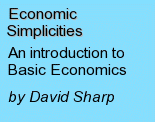




INTRODUCTION TO
ECONOMICS
Lesson 7 of 2006
Division of Labour
Division of Labour
is the term used in economics to refer to the specialisation that occurs
when different functions or roles are involved or used in the production
of goods and services. Among
economists, the benefits and significance of the division of labour are
a matter of some contention. To
a certain extent their particular attitude can be reflective of their
political viewpoint.
Various categories
of division of labour have been identified and distinguished including;
*Territorial
Division of Labour; This occurs when different regions or countries
specialise in the production of one or more products, exchanging them
for whatever else they require thus utilising the benefit of comparative
advantage. It is associated
with Globalisation.
* Temporal Division
of Labour; This occurs where production happens sequentially such as to
result in lumberjacks, sawmillers and carpenters or farmers, millers and
bakers rather than having one person make a table or bake a loaf of
bread from scratch.
*Social
Division of Labour; Division
based on such things as gender, ethnicity, caste or class reflecting
power rather than efficiency. Perhaps
the first division of labour was the split between so-called mens’ and
womens’ work, or the division within the household of the work of the
young, the old and the rest.
* Technological
Division of Labour; The
breaking up of production between workers within a factory or workplace
into different aspects or component parts for increased efficiency and
productivity. In the modern
world this is usually what is meant when the term “Division of
Labour” is used. It is associated with Capitalism and the systematic approach
of time and motion studies and Taylorism.
In this regard division of labour is sometimes said to belong
more to the field of production engineering than economics.
Development
Division of labour
is sometimes said to be a concept as old as work itself. The ancient Greek philosophers considered aspects of it in
their writings. Some
considered the desirability of pre-civilised life as attributable to the
absence of specialisation when all did the same, and that decline and
fall was associated with its inception.
Plato saw it as part of the natural inequality of man justifying
the creation of the state with the need for builders, weavers,
shoemakers and so forth to be supported.
Xenophon linked it to the development of cities and the growth in
population, which enabled shoemakers to move from making and repairing
all shoes to making alone and not repairing or vice versa, or to making
for just men and not women and so forth, with the result that they
became better at that which they did.
In modern times the
technological division of labour first seems to have been written about
in England by Sir William Petty in 1681, who wrote about the pioneering
work of the Dutch shipyards, where instead of building one ship and then
starting on another the workers were organised in teams each building a
different part of the boat and which were then put together.
Turgot, the French
Physiocrat writing in 1751 linked it to the creation of money, the
development of commerce and the accumulation of capital. The fact that
with the technological division of labour a worker produced only part of
a completed product meant its operation was precluded in a barter
economy
However the most
famous early writer on the division of labour was Adam Smith who, in
1776, saw it as the essential element in mankind’s progress.
His account of the pin factory is famous in the literature of
economics. Ten men, each
making entire pins, were capable of producing altogether less than 200
pins in a day. Yet dividing
the making of a pin into 18 operations and giving each of the ten, one
or two of such operations to perform enabled production to increase to
48,000 pins per day.
The division of
labour was also central in the works of Karl Marx.
Unlike Smith. Marx saw it as essentially evil. He particularly was concerned to draw a distinction between
technical division in which some form of cooperation was necessary and
the bulk of such division which was social and based on class and
status, which exploited the worker and resulted in his or her
alienation. Marx believed
in the eventual elimination of the division of labour and the arriving
at a situation where everyone would perform entire tasks for their own
satisfaction and wellbeing.
Some Perceived
Advantages
·
Productivity is increased
·
Workers are able to
achieve a higher standard of performance
·
Production is able to be
better organised and controlled.
·
Innovation and invention
is stimulated.
Some Perceived
Disadvantages
·
Workers tend to be
dehumanised or degraded in becoming somewhat in the nature of a machine
and making only a part of something
·
Workers become less
skilled, bored and lose pride in their work.
·
Division of labour results
in mass production and a loss of quality.
David Sharp
June 2006